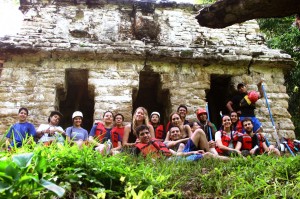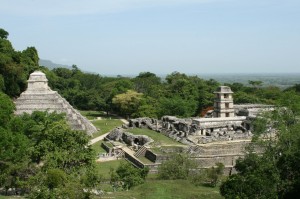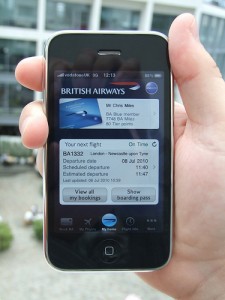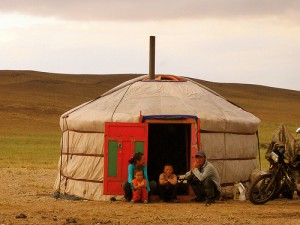
by Nicole Petrak, ATTA Special Projects & Assistant Editor, AdventureTravelNews
As the thawing of the consumer travel freeze continues, several trends will be key in marketing to travelers. Here are a few areas we’re monitoring for the second quarter of 2011.
MULTIGENERATIONAL TRAVEL - Keeping it in the family

Multigenerational travel has increasingly popped up on our radar over the past few years and is an especially hot topic on consumer news and travel sites these days. Virtuoso reports that trips of this nature are their top trend currently and have tripled in the past two years, while American Express Travel also includes it as one of their five major trends for 2011, noting that cruises and upscale all-inclusive vacations are popular in this expanding category.
This is likely because “3G” travel (defined as including family members from three generations) adds a new dimension of challenge in keeping the entire group — with a range of ages and backgrounds — comfortable and entertained on the same trip. Increasingly, consumers are turning to agents, tour operators and specialty travel packages to meet these complex needs. Virtuoso’s 2011 Luxe Report details an increase in requests for adventure travel activities for the whole family, often at several destinations during a trip - examples are zip-lining, hiking and fishing. Adventure tour operators should expect to be able to provide activities for all ages.
CAPTURING EMERGING MARKETS - What you need to know
According to the Truth, Myth and Pith: PhoCusWright's 2011 Travel Industry Trends webinar, the most important thing to consider in emerging travel markets is online penetration: emerging markets that have “missed the bus” in Travel 1.0 due to lack of widespread Internet access and adoption will be arriving in large numbers for Travel 2.0, using mobile devices and tablets to access travel sites and deals. According to PhoCusWright, China and India will continue to dominate the emerging market scene, while countries like Indonesia and Vietnam are really beginning to seize these technologies; in Latin America, travel purchases account for 40% of all online transactions, with Mexico and Brazil leading at the forefront with a significant amount of travel e-commerce.
They key takeaway from this is that if you want to reach these markets, you will need to be on top of mobile technology and applications for a range of devices, as well provide content that is multilingual and designed to appeal to different cultural and national audiences.
“At a minimum, companies should start reviewing their web sites on tablet and mobile devices to ensure they work well on these lower resolution devices — not all existing web sites display or function properly on tablet and mobile browsers,” says Jason Reckers, ATTA’s Director of Online Strategies. “In order to make effective use of limited time and resources, you should also prioritize what markets you’re targeting, research the ways consumers in those markets utilize online and mobile tools, and then target your online marketing and web development budget to meet those needs. “
LUXURY TRAVELERS GET A MAKEOVER

While the industry is seeing price sensitivity with a focus on value all across the market, the biggest shift may have occurred in luxury travelers. According to Virtuoso’s 2011 Luxe Report, this group cites “authentic experiences in new destinations” as their top motivation for traveling this year, above R&R and socializing. The same report reveals that value for money paid (79%) and once-in-a-lifetime experiences (57%) are top factors in choosing destinations, and 33.2% of Virtuoso agents named active and adventure travel among the top five biggest trends of 2011.
"People are not flaunting their wealth; it is all about having out-of-the-world experiences," says Simon Mayle of International Luxury Travel Market (ILTM), quoted in a recent Wall Street Journal (WSJ) article, Rediscovering a Sense of Adventure. In a shift away from ‘sun and sand’ holidays, high-end travelers are consistently seeking trips that are rich in physical, educational and cultural factors and help them meet personal goals, as well as destinations that are “Off the Beaten Track” (WSJ reports Latin America as the big winner in this category, with Chile, northern Colombia, Pantanal in Brasil, Pueblos Mágicos in Mexico, the Atacama Desert, and Bolivia's salt flats popping up on travel wishlists).
"It is the search for a unique experience where you reap benefits as well, such as climbing Kilimanjaro," says Michelle Grant of Euromonitor International. Virtuoso also finds that more unusual destinations such as Antarctica and Madagascar are becoming popular, as are hiking and walking trips in places like Nepal, Bhutan, North Korea, Libya, Lebanon, and Cyprus. Additionally, their agents have cited a rise in requests from luxury travelers for “unique, hands-on experiences that inspire a personal connection and will build lasting memories: cooking classes; staying in African villages to become part of the culture and community; visiting local schools.”
In terms of luxury travel numbers, International Luxury Travel Market Leaders Forum posted in a recent press release that the industry will have to wait for 2012 for a more holistic return of global luxury travel, but points out that significant growth in China and India is changing the current face of the luxury traveler.
“The Indian luxury market comprises regular guests rather than aspirational travellers saving for a one-off luxury holiday,” says Small Luxury Hotels of the World (SLH) CEO, Paul Kerr. “And just like any other luxury traveller, the Indian millionaire wants freedom of choice.” Bookings out of India last year grew by 129%, and the Indian luxury market is set to expand at a rate of 21% with luxury travel growing at approximately 15% over the next 5 years, representing a fast-emerging, high-spending sector across Asia as a whole. The ILTM Leaders Forum projects 100 million outbound travellers from mainland China and 50 million from India by 2020.
MAKING SENSE OF SMART TECHNOLOGIES

Of the ten trends named by PhoCusWright in the 2011 Truth, Myth and Pith report, three we find most salient centered around smart technologies and the game-changing impact they’re having on the travel industry.
The first is that mobile is not actually a trend, but now part of the fabric of the consumer landscape. Expedia has seen mobile bookings rise by 5 times in 2010; Kayak now has more people developing for mobile than for the web; mobile payments are expected to become a reality this year; and PhoCusWright predicts a shift towards in-destination bookings as well (currently with a bias towards lower purchase points, such as motels). Mobile has permeated all areas of the travel industry — there will be no such thing as a static mobile strategy for travel businesses.
The second trend taking place is suppliers are getting smart about smart technologies. As mobile 1.0 gives way to 2.0, we’ll move away from a framework of consumers simply accessing what they need in the moment (reservation numbers, contact information) to a more sophisticated model that considers what they want while they’re on the road. Think interactivity. Perhaps it’s a trail map on cycling customers’ phones that can lead them on self-guided tours or alert them when in proximity to special local destinations, or the ability to download videos about Maya history or review photos and English menus of “locals’ only’”restaurants onto their iPad while traveling in Chiapas, Mexico, to guide them to more authentic and quality options. How can your company harness real time connectivity and location based services to enhance - or even change - the travel experience?
Last but not at all least is that tablet wars will spark a travel revolution as their popularity rises and competition between manufacturers increases. Immersive and entertainment-oriented, expect them to travel with your consumers and be ready to connect with them via their tablets throughout the entire process, from trip research to post-trip feedback and content.
“These smart technology trends in web, mobile, and tablets are important and exciting to follow, but likely leave you feeling anxious and overwhelmed. Don’t let the complexities of these new trends and technologies hold you back from moving forward,” adds Reckers of ATTA. “A good first step is to understand your current and potential customer base and where those customers will most likely access your products and services. Whether they’re finding you through a mobile device, the concierge at the local hotel, or while booking a cruise online, each of these scenarios require a different game plan.”
Experimental, Sustainable, Demanding - GET READY FOR THE NEW CONSUMER

Last quarter the ATTA suggested that consumer preferences for sustainability would become more discerning and insistent as the world sees the rise of the LOHAS, or ‘Lifestyles of Health and Sustainability’ consumers who are increasingly aware of greenwashing practices and sensitive to environmentally and socially sustainable products.
Research from leading global communications company Euro RSCG Worldwide explores this movement further with a survey of 5,700 people from Brazil, China, France, Japan, Netherlands, the UK and the US, revealing a shift in consumer consciousness that is centered on a critical attitude towards hyper-consumerism and a focus on a more mindful approach to living and consuming. The results of the New Consumer study are the basis for a white paper and blog on www.TheNewConsumer.com, which explains:
- New Consumers are quickly becoming smarter shoppers who are both more empowered and more demanding
- They make full use of online tools for consumer research —they seek out product info, reviews, ratings and price comparisons
- They increasingly prefer their peers for guidance and consumption advice, versus “experts”
- These consumers remain anxious about their finances and the cost of living both now and in the future
- They are seeking change in their personal lives and in the world around them - this includes the belief that society has grown too intellectually and physically lazy, and is too disconnected from the natural world
- It is important to new consumers to reduce negative social and environmental impacts - 65% believe they have a responsibility to avoid unethical companies, 57% value supporting local producers, artisans, and manufacturers, and 45% say they want to buy locally produced goods. Almost half are willing to pay a slightly higher price for products that are socially or environmentally responsible.
- Roughly half of them report wanting brands to share their personal values, with which they can feel good about doing business with, and that have a reputation for a ‘purpose beyond profits’
“Transforcations” - According to the WSJ, this increasingly popular type of travel helps people achieve goals, learn and experience new things, push beyond their limits. These transformative vacations could include adventure travel, boot camp type experiences, volunteer travel or cultural travel with a focus on education.
Experiential travel - American Express Travel predicts that river cruising sales will rise as people look for all-inclusive travel that emphasizes a deeper look at local culture and history, along with a more intimate experience, as well as ‘Expert-cation’ itineraries crafted around specific interests (think food, sports, yoga, history) or even more niche travel like knitting cruises or salsa dancing classes. They emphasize travelers’ desire for exclusive tours and viewings, and hands-on, unique experiences.
